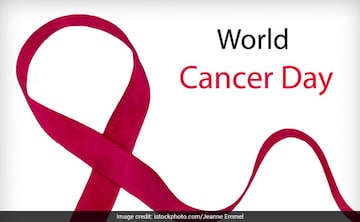By Hon. (Dr.), Amb. Angela Anthony

What is Cancer? Join me to find out what it is-
Find out more about different types of cancers, prevention, early detection and cancer treatment.
Key Cancer Facts
~Cancer is the second-leading cause of death worldwide.
~10 million people die from cancer every year.
~More than 40% of cancer-related death could be preventable as they are linked to modifiable risk factors such as smoking, alcohol use, poor diet and physical inactivity.
~Almost at least one third of all deaths related to cancer could be prevented through routine screening, and early detection and treatment.
~70% of cancer deaths occur in low-to-middle income countries.
~Millions of lives could be saved each year by implementing resource appropriate strategies for prevention, early detection and treatment.
~The total annual economic cost of cancer is estimated at US$1.16 trillion.
World Cancer Day petition
We encourage everyone to ask their governments to improve health equity, to make it easier for all populations to enjoy affordable and accessible cancer services, and to reduce disparities in cancer incidence and mortality.
What is cancer ?
Cancer is a disease which occurs when changes in a group of normal cells within the body lead to uncontrolled, abnormal growth forming a lump called a tumour; this is true of all cancers except leukaemia (cancer of the blood). If left untreated, tumours can grow and spread into the surrounding normal tissue, or to other parts of the body via the bloodstream and lymphatic systems, and can affect the digestive, nervous and circulatory systems or release hormones that may affect body function.
Cancer tumours can be divided into three groups: benign, malignant or precancerous.
~Benign tumours are not cancerous and rarely threaten life. They tend to grow quite slowly, do not spread to other parts of the body and are usually made up of cells quite similar to normal or healthy cells. They will only cause a problem if they grow very large, becoming uncomfortable or press on other organs – for example a brain tumour inside the skull.
~Malignant tumours are faster growing than benign tumours and have the ability to spread and destroy neighbouring tissue. Cells of malignant tumours can break off from the main (primary) tumour and spread to other parts of the body through a process known as metastasis. Upon invading healthy tissue at the new site they continue to divide and grow. These secondary sites are known as metastases and the condition is referred to as metastatic cancer.
~Precancerous (or premalignant) describes the condition involving abnormal cells which may (or is likely to) develop into cancer.
Types of cancers
Cancer can be classified according to the type of cell they start from. There are five main types:
Carcinoma – A cancer that arises from the epithelial cells (the lining of cells that helps protect or enclose organs). Carcinomas may invade the surrounding tissues and organs and metastasise to the lymph nodes and other areas of the body. The most common forms of cancer in this group are breast, prostate, lung and colon cancer.
Sarcoma – A type of malignant tumour of the bone or soft tissue (fat, muscle, blood vessels, nerves and other connective tissues that support and surround organs). The most common forms of sarcoma are leiomyosarcoma, liposarcoma and osteosarcoma.
Lymphoma and Myeloma – Lymphoma and Myeloma are cancers that begin in the cells of the immune system. Lymphoma is a cancer of the lymphatic system, which runs all through the body, and can therefore occur anywhere. Myeloma (or multiple myeloma) starts in the plasma cells, a type of white blood cell that produces antibodies to help fight infection. This cancer can affect the cell’s ability to produce antibodies effectively.
Leukaemia – Leukaemia is a cancer of the white blood cells and bone marrow, the tissue that forms blood cells. There are several subtypes; common are lymphocytic leukaemia and chronic lymphocytic leukaemia.
Brain and spinal cord cancers – these are known as central nervous system cancers. Some are benign while others can grow and spread.
*Causes and risk factors of cancer *
Cancers can be caused by a number of different factors and, as with many other illnesses, most cancers are the result of exposure to a number of different causal factors. It is important to remember that, while some factors cannot be modified, around one third of cancer cases can be prevented by reducing behavioural and dietary risks.
~Modifiable risk factors include:
It is important to note that income and education levels, national policies, industry tactics with vested commercial interests, and genetics, are all factors that can make it very difficult to act on a modifiable factor and change behaviour at the individual level.
▪︎Alcohol – The evidence that all types of alcoholic drinks are a cause of a number of cancers is now stronger than ever before. Alcohol can increase the risk of six types of cancers, including bowel (colorectal), breast, mouth, pharynx and larynx (mouth and throat), oesophageal, liver and stomach.The evidence suggests that in general, the most alcohol drinks people consume the higher the risk of many cancers, and that even moderate alcohol intake increases the risk of cancer.
▪︎Being overweight or obese – Excess weight has been linked to an increased risk of developing 12 different cancers, including bowl and pancreatic cancers. In general, greater weight gain, particularly as adults, is associated with greater cancer risks. In general, greater weight gain, particularly as adults, is associated with greater cancer risks.
▪︎Diet and nutrition – Experts suggest that diets and nutritional intake, particularly diets high in red meats, processed meats, salted foods and low in fruits and vegetables have an impact on cancer risks, particularly colorectum, nasopharynx and stomach1, 2, 3.
▪︎Physical activity – Regular physical activity not only helps to reduce excess body fat and the cancer risks associated with this, but being physically active can help to reduce the risks of developing colon, breast and endometrial cancers.
▪︎Tobacco – Tobacco smoke contains at least 80 different cancer-causing substances (carcinogenic agents). When smoke is inhaled the chemicals enter the lungs, pass into the blood stream and are transported throughout the body. This is why smoking or chewing tobacco not only causes lung and mouth cancers but is also related to many other cancers. The more a person smokes, the younger they start, and the longer they keep smoking, all further increase the risk of cancer.
Currently tobacco use is responsible for around 22% of cancer deaths.
▪︎Ionising radiation – Manmade sources of radiation can cause cancer and are a risk for workers. These include radon, x-rays, gamma rays and other forms of high-energy radiation.
▪︎Prolonged and unprotected exposure to ultraviolet radiations from the sun, sunlamps and tanning beds can also lead to melanoma and skin malignancies. Fair skinned people, individuals with a lot of moles or who have a family history of melanoma or non-melanoma skin cancer, are at highest risk.
However, people of all skin tones can develop skin cancer, including individuals with darker skin.
Work place hazards – Some people risk being exposed to a cancer-causing substance because of the work that they do. For example, workers in the chemical dye industry have been found to have a higher incidence than normal of bladder cancer. Asbestos is a well-known workplace cause of cancer – particularly a cancer called mesothelioma, which most commonly affects the covering of the lungs.
▪︎Infection – Infectious agents are responsible for around 2.2 million cancer deaths annually. This does not mean that these cancers can be caught like an infection; rather the virus can cause changes in cells that make them more likely to become cancerous. Around 70% of cervical cancers are caused by Human papillomavirus (HPV) infections, while liver cancer and Non-Hodgkin Lymphoma can be caused by the Hepatitis B and C virus, and lymphomas are linked to the Epstein-Barr virus. Bacterial infections have not been thought of as cancer-causing agents in the past, but more recent studies have shown that people who have helicobacter pylori infection of their stomach develop inflammation of the stomach lining, which increases the risk of stomach cancer.
Non-modifiable risk factors include:
¤Age – Many types of cancer become more prevalent with age. The longer people live, the more exposure there is to carcinogens and the more time there is for genetic changes or mutations to occur within their cells.
¤Cancer-causing substances (carcinogens) – are substances which change how a cell behaves, increasing the chances of developing cancer. Genes are the coded messages inside a cell that tell it how to behave (i.e. which proteins to make), mutations or changes to the gene, such as damage or loss, can alter how that cell behaves making it more likely to be cancerous.
¤Genetics – Some people are unfortunately born with a genetically inherited high risk for a specific cancer (‘genetic predisposition). This does not mean developing cancer is guaranteed, but a genetic predisposition makes the disease more likely.
For example, women that carry the BRCA 1 and BRCA 2 breast cancer genes have a higher predisposition to developing this form of cancer than women with a normal breast cancer risk.
However, less than 5% of all breast cancer is known to be due to genes. So, although women with one of these genes are individually more likely to develop breast cancer, most cases are not caused by a high risk inherited gene fault. This is true of other common cancers where some people have a genetic predisposition – for example, colon (large bowel) cancer.
¤The immune system – People who have weakened immune systems are more at risk of developing some types of cancer. This includes people who have had organ transplants and take drugs to suppress their immune systems to stop organ rejection, plus people who have HIV or AIDS, or other medical conditions which reduce their immunity to disease.
Signs and symptoms of cancer
With so many different types of cancers, the symptoms are varied and depend on where the disease is located. However, there are some key signs and symptoms to look out for, including:
Unusual lumps or swelling – cancerous lumps are often painless and may increase in size as the cancer progresses
Coughing, breathlessness or difficulty swallowing – be aware of persistent coughing episodes, breathlessness or difficulty swallowing
Changes in bowel habit – such as constipation and diarrhoea and/or blood found in the stools
Unexpected bleeding – includes bleeding from the vagina, anal passage, or blood found in stools, in urine or when coughing
Unexplained weight loss – a large amount of unexplained and unintentional weight loss over a short period of time (a couple of months)
Fatigue – which shows itself as extreme tiredness and a severe lack of energy. If fatigue is due to cancer, individuals normally also have other symptoms:
Pain or ache – includes unexplained or ongoing pain, or pain that comes and goes
New mole or changes to a mole – look for changes in size, shape, or colour and if it becomes crusty or bleeds or oozes.
Complications with urinating – includes needing to urinate urgently, more frequently, or being unable to go when you need to or experiencing pain while urinating.
Unusual breast changes – look for changes in size, shape or feel, skin changes and pain
Appetite loss – feeling less hungry than usual for a prolonged period of time
A sore or ulcer that won’t heal – including a spot, sore wound or mouth ulcer
Heartburn or indigestion – persistent or painful heartburn or indigestion
Heavy night sweats – be aware of very heavy, drenching night sweats
Preventing cancer
Over a third of all cancers can be prevented by reducing your exposure to risk factors such as tobacco, obesity, physical inactivity, infections, alcohol, environmental pollution, occupational carcinogens and radiation.
Prevention of certain cancers may also be effective through vaccination against the Hepatitis B Virus (HBV) and the Human Papilloma Virus (HPV), helping to protect against liver cancer and cervical cancer respectively.
Reducing exposures to other carcinogens such as environmental pollution, occupational carcinogens and radiation could help prevent further cancers.
Early detection of cancer
There are a number of cancers which can be identified early which helps to improve the chances of successful treatment outcomes, often at lower costs and with fewer (or less significant) side effects for patients. There are cost-effective tests that help detect colorectal, breast, cervical and oral cancers early and further tests are being developed for other cancers.
Check with your doctor for guidance on the national recommendations regarding vaccinations, testing and screenings. These can and do vary from country to country.
Cancer staging
The classification of cancer by anatomical extent of the disease, i.e. stage, is essential to patient care, research and cancer control. The UICC TNM staging system is the common language adopted by oncology health professionals to communicate on the cancer extent for individual patients. Once the stage of cancer is known and understood, this is often a basis for deciding appropriate treatment and individual prognosis. It can also be used to inform and evaluate treatment guidelines, and constitutes vital information for policy-makers developing or implementing cancer control, prevention plans and research.
■The TNM classification focuses on the anatomical extent of the tumour and is determined by assessing the following categories:
•T describes the size of the main (primary) tumour
•N describes whether the cancer has spread to the nearby lymph nodes
•M describes whether the cancer has metastasised (spread from the primary tumour to another part of the body)
*Managing and treating cancer *
Your treatment depends on the type of cancer, where your cancer is, how big it is, whether it has spread, and your general health. The general types of treatments include: surgery, chemotherapy, radiotherapy, hormone therapy, immunotherapy, and gene therapy.
-Surgery
If a cancer has not metastasised (spread), surgery can remove the entire cancer which may completely cure the disease. Often, this is effective in removing the prostate or a breast or testicle.
-Radiotherapy
Radiation treatment or radiotherapy uses high-energy rays to reduce a tumour or destroy cancer cells as a stand-alone treatment and in some cases in combination with other cancer treatments.
-Chemotherapy
Chemotherapy uses chemicals to interfere with the way cells divide – damaging of DNA – so that cancer cells will destroy themselves. These treatments target any rapidly dividing cells (not necessarily just cancer cells), but normal cells usually can recover from any chemical-induced damage while cancer cells cannot. Chemotherapy is generally used to treat cancer that has spread or metastasised because the medicines travel throughout the entire body. It is a necessary treatment for some forms of leukaemia and lymphoma.
-Immunotherapy
Immunotherapy uses the body’s own immune system to fight the cancer tumour. Immunotherapy may treat the whole body by giving an agent that can shrink tumours.
-Hormone therapy
Several cancers have been linked to some types of hormones, including breast and prostate cancer. Hormone therapy works to change hormone production in the body so that cancer cells stop growing or are killed completely.
-Gene therapy
The goal of gene therapy is to replace damaged genes with ones that work to address a root cause of cancer: damage to DNA. Other gene-based therapies focus on further damaging cancer cell DNA to the point where the cell destroys themselves. However, gene therapy is new and has not yet resulted in any successful treatments.
-Survivorship
Survivorship focuses on health and the physical, psychological, social and economic issues affecting people after the end of the primary treatment for cancer, including people who have no disease after finishing treatment, people who continue to receive treatment to reduce the risk of the cancer coming back and people with well controlled disease and few symptoms, who receive treatment to manage cancer as a chronic disease.
Survivorship care includes issues related to follow-up care, the management of late side-effects of treatment, the improvement of quality of life and psychological and emotional health. Survivorship care includes also future anticancer treatment where applicable. Family members, friends and caregivers should also be considered as part of the survivorship experience.
-Palliative care
Palliative care runs throughout a patient’s journey from diagnosis to cure or end of life, and is designed to relieve symptoms and improve a cancer patient’s quality of life. It can be used to respond to troubling symptoms such as pain or sickness, and also to reduce or control the side effects of cancer treatments. In advanced cancer, palliative treatment might help someone to live longer and to live comfortably, even if they cannot be cured.
CREDIT: © 2024 UICC | World Cancer Day.
World Cancer Day is an initiative of the
Union for International Cancer Control (UICC)
UICC is a registered non-profit association.
Article shared by:
Hon. (Dr.), Amb. Angela Anthony Oju-Kienmie, FEPHM,
Vice Chairman/ Supervisor For Health,
Opobo /Nkoro Local Government Area,
Rivets State.
Sunday, February 4, 2024
01:15AM
Health
WorldCancerDay
SundayFebruary42024
HealthAdvocate
CreatingAwareness




